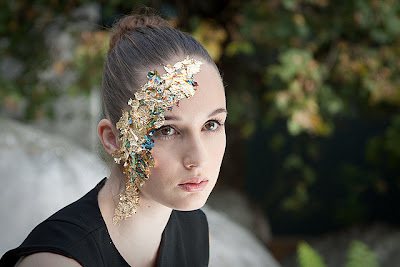Most beginner photographers might have had this advice from seniors – do not shoot - in direct sunlight / during noon / midday / sunny day / bright light etc. The exact words or construction of sentence may differ but the message is always the same. Do not shoot in harsh sunlight, but unfortunately that is not always practical. You will need to photograph under direct sunlight often and having knowledge of how to get the best out of the situation will be very helpful. So in this article we will discuss how to photograph in bright sunlight.
 |
| Photo By Asim Bharwani |
The major issues associated with photographing in direct sunlight are of blown out highlights, clipped shadows, lens flare, squinting subjects and over saturation.
The two main problems that is of blown out highlights and clipped shadows are due to the lower dynamic range that your camera is capable of capturing. If contrast between the highlights and shadows are beyond the dynamic range of the camera then you will lose details in both. Or if you expose for any one you will lose the other. Let us see how best we could tackle this issue.
If you could re-compose your shot by choosing a different shooting angle there by reducing contrast try it and check your histogram to see how much of effect does it has.
If you are photographing people or any other subject that could be moved into the shade then you have successfully solved the issue.
The two main problems that is of blown out highlights and clipped shadows are due to the lower dynamic range that your camera is capable of capturing. If contrast between the highlights and shadows are beyond the dynamic range of the camera then you will lose details in both. Or if you expose for any one you will lose the other. Let us see how best we could tackle this issue.
1. Try a different Shooting Angle
If you could re-compose your shot by choosing a different shooting angle there by reducing contrast try it and check your histogram to see how much of effect does it has.
2. Move your Subject into the shade
If you are photographing people or any other subject that could be moved into the shade then you have successfully solved the issue.
 |
| Photo By Christian Yves |
3. Use Reflectors
Use reflectors to reflect back light so as to fill in the shadows, revealing more shadow detail and reducing the contrast between the highlights and shadows. Foldable reflects now come with many finishes Gold, Silver, White, Translucent etc. They are handy to carry around and also do not require a power source.
 |
| Photo By Daniel Pfund |
4. Use Flash as Fill
Using a flash unit as a fill light source gives you more control over the lighting than when using reflectors. Portable flash units are very convenient to use on location as they are very compact, weighs less and also needs no access to external power sources.
 |
| Photo By Chemisti |
How to Avoid Lens Flare
Lens flare is a major issue when shooting into the sun. It is caused by stray light that enters the lens from various angles other than the ones that form the image. The easiest way to avoid causing lens flare is to use a proper lens hood.
 |
| Photo By Andrew Hefter |
How to Tame Harsh Sunlight
You will come across many challenging situations when shooting in bright sunlight, some of the common issues are that of tackling specular reflections, need to use wider apertures, need to use slower shutter speeds, getting details, depth and colour in sky etc. The solution to these issues lies in the form of filters. Knowing how to use them could give you much more control over the variables when shooting in bright sunlight.
Use Filters
1. Circular Polariser Filter
A circular polariser filter is very useful to reduce specular reflections arising from the shiny surfaces in your frame. It also helps to get more saturated colours and really brings out the details in the skies.
 |
| Photo By Steven Martin |
2. Neutral Density Filter
A neutral density filter helps reduce the amount of light entering the camera. The amount of light reduced depends upon the intensity of the filter being used. It does not add a colour cast to the image but only reduces its intensity. It is very helpful as it allows the use of slower shutter speeds and also wider apertures in bright lighting conditions. It is also helpful when trying to match sunlight with other artificial light sources like flashes and strobes.
 |
| Photo By Dr Whimsy |
3. Graduated Neutral Density Filter
A graduated neutral density filter is one which has filtering effect only in one portion and gradually shifts to pure filter as a gradient. It is very useful in situations where one part of the scene is very brightly lit than the other.
 |
| Photo By Chris Gin |
Use Scrims or Diffusers
Using Scrims or Diffusers to control the amount and quality of light that falls on your subject is also very effective and could easily help achieve even, soft light from the harsh sunlight. The amount of softness and also quantity of light falling on the subject could be controlled by varying the size and also the distance (in relation to the subject) of the diffuser / scrim.
Make use of Locational Elements
Locational elements like a huge tree or a big white wall etc could be used to your advantage. The wall or any such surface could act as a giant reflector, filling in the shadows, where as the tree could either provide shade which is ideal to shoot or it could provide dappled light, sort of effect you get while using a cookie, which could also give a unique feel to your image.
Creative Tips to Shoot in Direct Sun Light
1. Shoot in RAW
Shooting in RAW will give you much more control over the elements when post processing, you could adjust the highlights, recover details and fill in shadows etc. shooting in RAW also gives you the option to choose your white balance settings later while editing. So whenever faced with a difficult situation shift your image format to RAW.
2. Experiment With your Metering Mode
Try spot metering on your subject rather than evaluative metering when shooting portraits. Experiment with the various metering modes and choose the one that best suits your subject or scene.
3. Bracket Your Shots
Use Automatic Exposure Bracketing setting on your camera to bracket your shots, use this when shooting important scenes so that if needed you could create a perfectly exposed composite image out of those different exposures, or perhaps an HDR.
4. Shoot Silhouettes
You could actually take advantage of the huge difference in contrast by shooting creative silhouettes of your subjects. Silhouettes offer a lot of scope for storey telling if you arrange elements skilfully.
 |
| Photo By Vandan Desai |
5. Shoot Shadow Portraits
Shooting shadows and telling stories via them is one creative trick you could try in harsh sunlight. Come up with original ideas and you will be amazed at how much visual interest these pictures gather.
 |
| Photo By Martin Biskoping |
In the next article we will discuss about Photography - Tips For Beginners - 10 Questions To Ask Yourselves Before Taking a Picture
Post a Comment